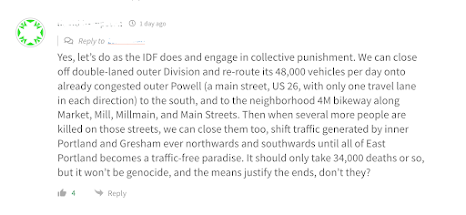A recent article at BikePortland.org discussed the ongoing effects of rampant homelessness on various aspects of Portland’s livability. It’s nothing new; homelessness was already prevalent before the pandemic, and Covid made everything a thousand times more dire all around.
Before the pandemic, when I rode my bike downtown more often, it was still possible to lock up at many of my favorite spots and feel fairly certain that my bike would be secure. There were also lots more places to patronize, which meant I could ride downtown for one purpose and enjoy a couple of side visits along the way.
Not so much anymore.
Now, I only go downtown to see my doctor, or to change buses before leaving downtown again to go somewhere else. I will pass an average number of between ten and twenty people who are pushing shopping carts or carrying large bags filled with personal belongings, wearing shoes that are woefully worn out and several sizes too big, and most of whom don’t look like they’ve bathed in a couple of weeks.
What’s worse, many of these people are also suffering from the effects of substance abuse, substance withdrawal or untreated mental illness. They argue out loud with no one, shake their fists menacingly at a car or truck that passes too close or too fast, or even get up within three inches of my face to demand a dollar, or five. There’s security around the medical building where my doctor is, so I feel at least relatively safe. But beyond those confines, anything can happen. The last time I rode my bike downtown for a doctor’s appointment was in May, when I rode to the light rail, hopped on and got off within ten blocks of the clinic. I double-locked my bike, and came out afterwards finding someone trying to break both locks. I went in, asked the security guard to come out with me and held up my key to indicate the bike was mine. He wouldn’t go back out with me. “I’m not responsible for your bicycle,” he said. “Maybe next time, just take the bus.”
I’ve been taking the bus to the doctor since then. Since I can’t ride the full distance anymore and there are far fewer places for me to visit downtown now, it’s just not worth the stress or risk.
Many of the restaurants, coffee shops and little stores I used to enjoy frequenting are gone now, and most of the spaces are still unleased and boarded up. The anecdotal evidence is clear that there are far more homeless people hanging out downtown now than there were in 2020. The Mayor-elect promises to reopen overnight shelters in January after he takes office, but that won’t do much to solve the problem. It won’t bring back the many businesses that have left downtown. It won’t make the rent more affordable on vacant apartments downtown and in South Waterfront. It won’t increase the availability of drug treatment and mental health treatment. And it won’t compel homeless people who refuse assistance and structured shelter to go somewhere else. Because even if more people were in favor of making the willfully homeless move on, there are still so many who prefer to take the most compassionate approach possible and allow them to stay where they are.
That’s fine until someone sleeping in a tent too close to the curb is killed by a passing car.
Or until someone camping near a school intimidates and threatens students and faculty.
Or an angry homeowner, impatient with police response, decides to take the law into his own hands and drive through an encampment too near to his house.
Or until someone desperate enough tries to rob an elderly person waiting for a bus.
Any of those scenarios are possible.
Yes, the people sleeping under tarps and in tents and RVs broken down at roadside have nowhere else to go, and no resources to help them improve their lot. The rent is too damned high, even for someone with a full-time hourly wage job. And every business that closes and leaves town deprives the community of dozens or more jobs. It is a spiral and no one seems able to do anything to stop it. The people who could stop it — the wealthiest among us — do nothing, because they need that fear of scarcity to keep everyone else in line. They need those of us with less fighting for too few resources and not planning an attack on the CEO’s and shareholders who run the corporations that run the country.
I don’t like that a health insurance CEO was gunned down in broad daylight by someone who was angry about the system. But I won’t pretend that I don’t understand it, either. It happened because one man was fed up and decided he’d had enough, and felt he had no other options. That young man did not operate in isolation. There are others far more desperate and angry who might consider doing the same thing.
I hate living in a world where that’s not only possible, but now more probable. And I hate living in a world where the corporate response is to beef up security for those at the top, rather than to consider a more humane approach to providing health coverage to those in need.
And since I cannot prevent homelessness, or solve it, I have to take more precautions when, where and how I go out.
I hate that we find ourselves here.
But this is where we are.

















